Abstract
Pruritus in hepatobiliary disease is commonly believed to be caused by retention of bile acids with their sequestration in the skin. HOwever, we have recently demonstrated that skin levels of bile acids in patients with cholestasis correlate poorly with pruritus. In this report, we present additional data concerning the relationship of pruritus to bile acid retention: (1) the urinary excretion of sulfated and nonsulfated bile acids was not significantly different in patients with cholestasis who itched compared to those who did not; (2) one patient with itch associated with a liver abscess had normal levels of bile acids in serum, skin, and urine; (3) patients with primary biliary cirrhosis who itched had lower serum bile acid levels than patients with mechanical biliary obstruction who did not itch.
These studies support our premise that pruritus in hepatobiliary diseases is not directly related to bile acid retention. They suggest that the type of cholestatic disorder, and not simply the magnitude of the cholestasis, as estimated by the elevation of serum bile acids, is important. We propose that the agent responsible for pruritus is produced in response to cholestasis, possibly through activation of the alternate pathway of bile acid synthesis. Properties of the hypothetical pruritogen are discussed.
Full text
PDF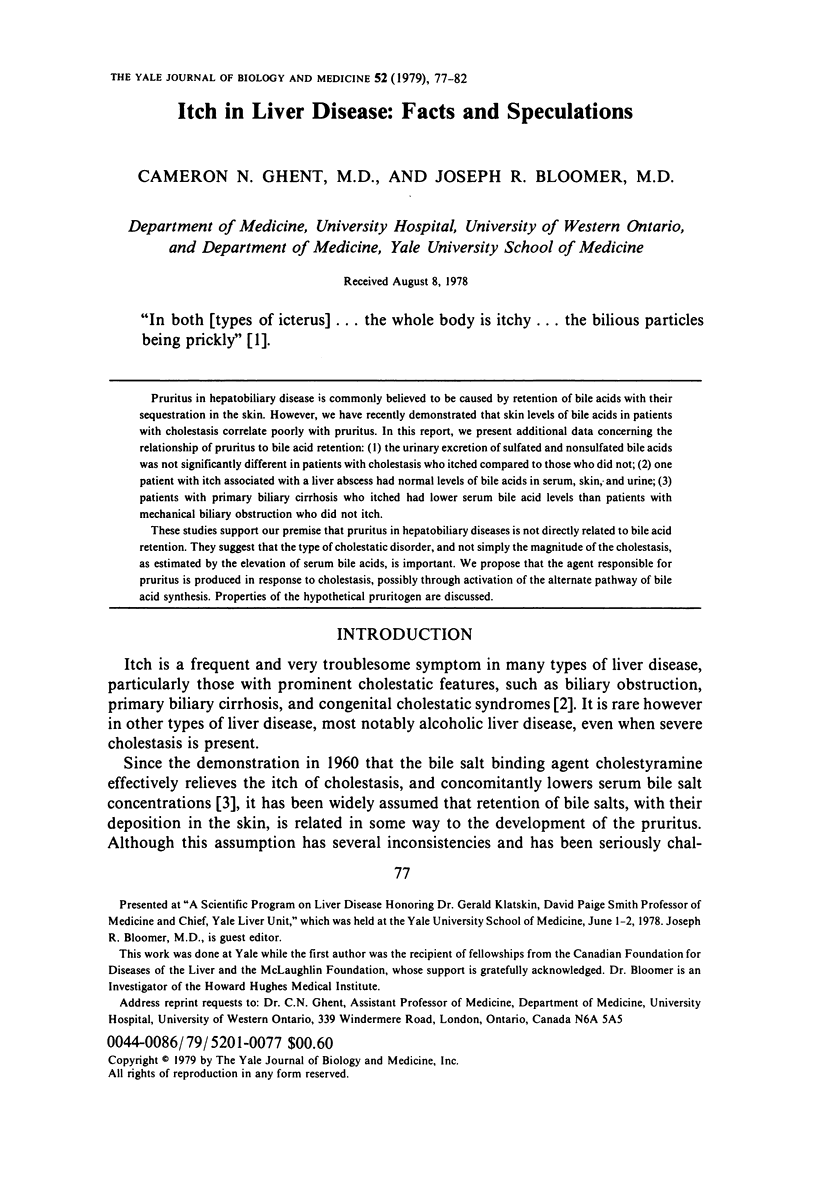
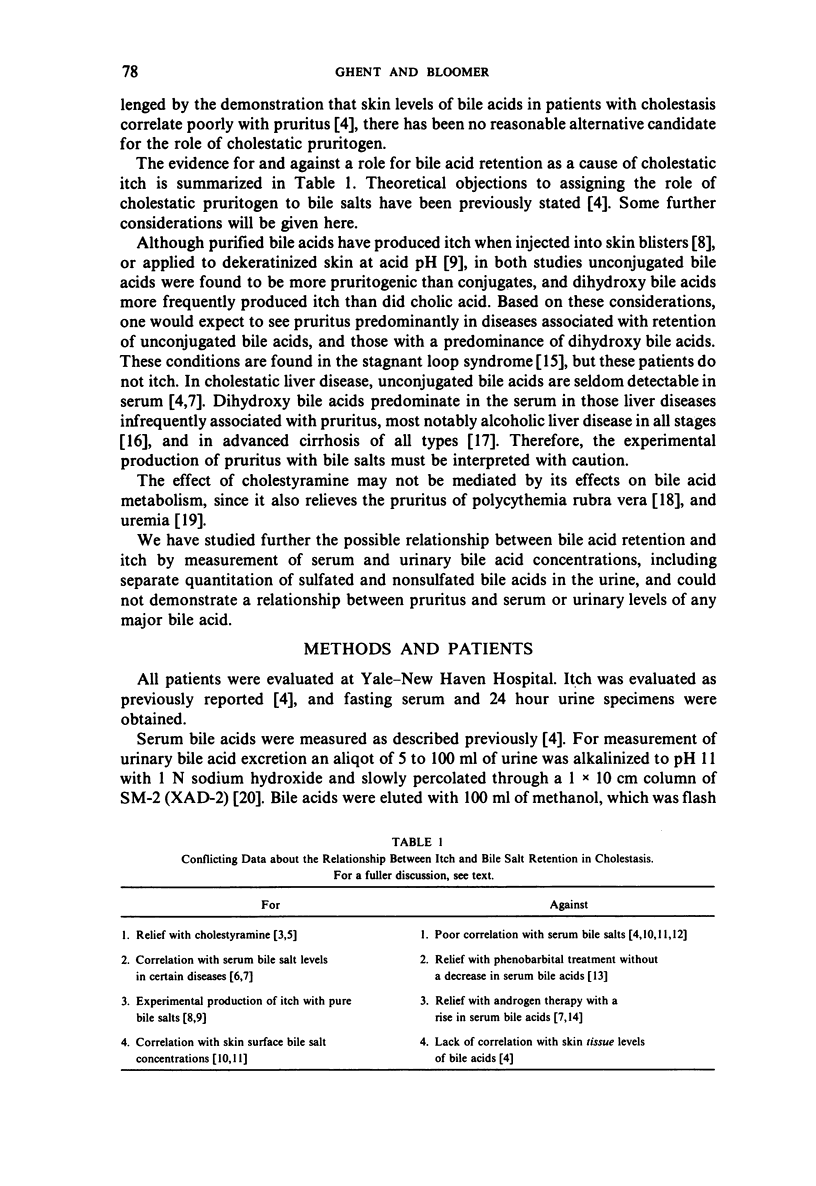
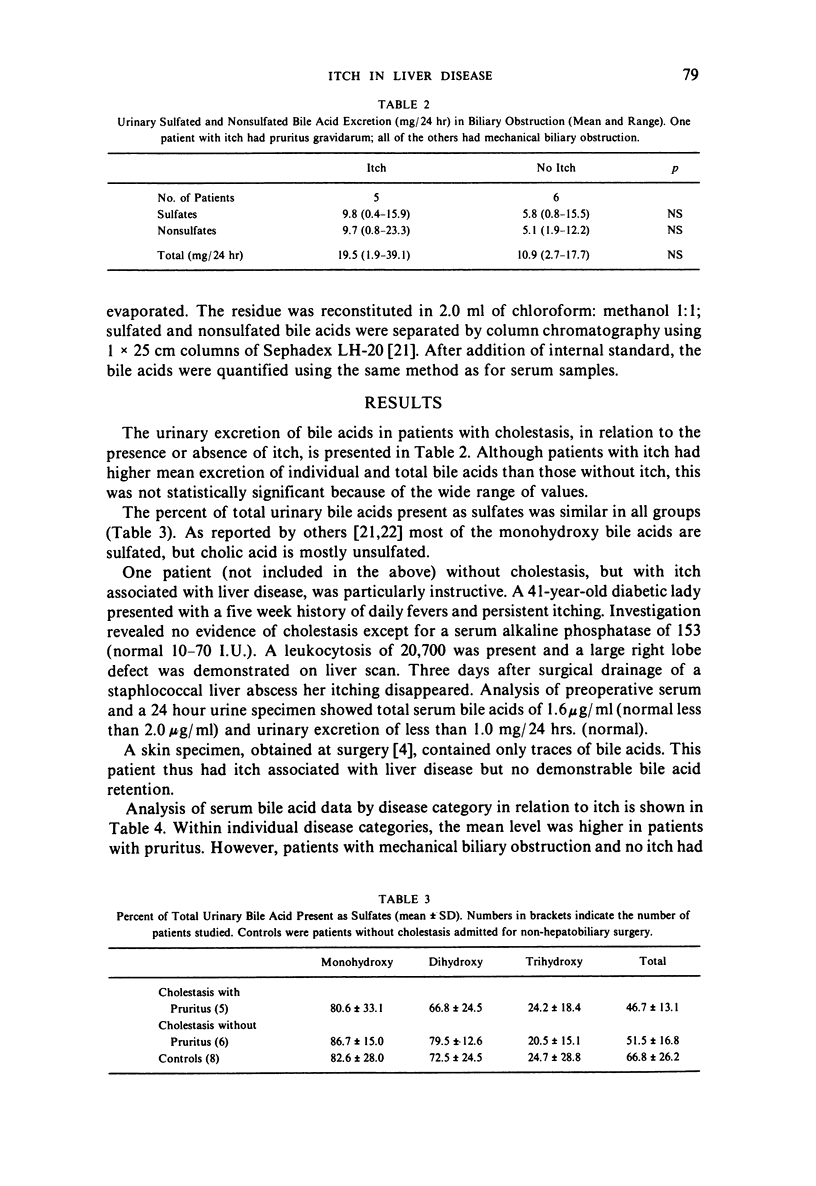
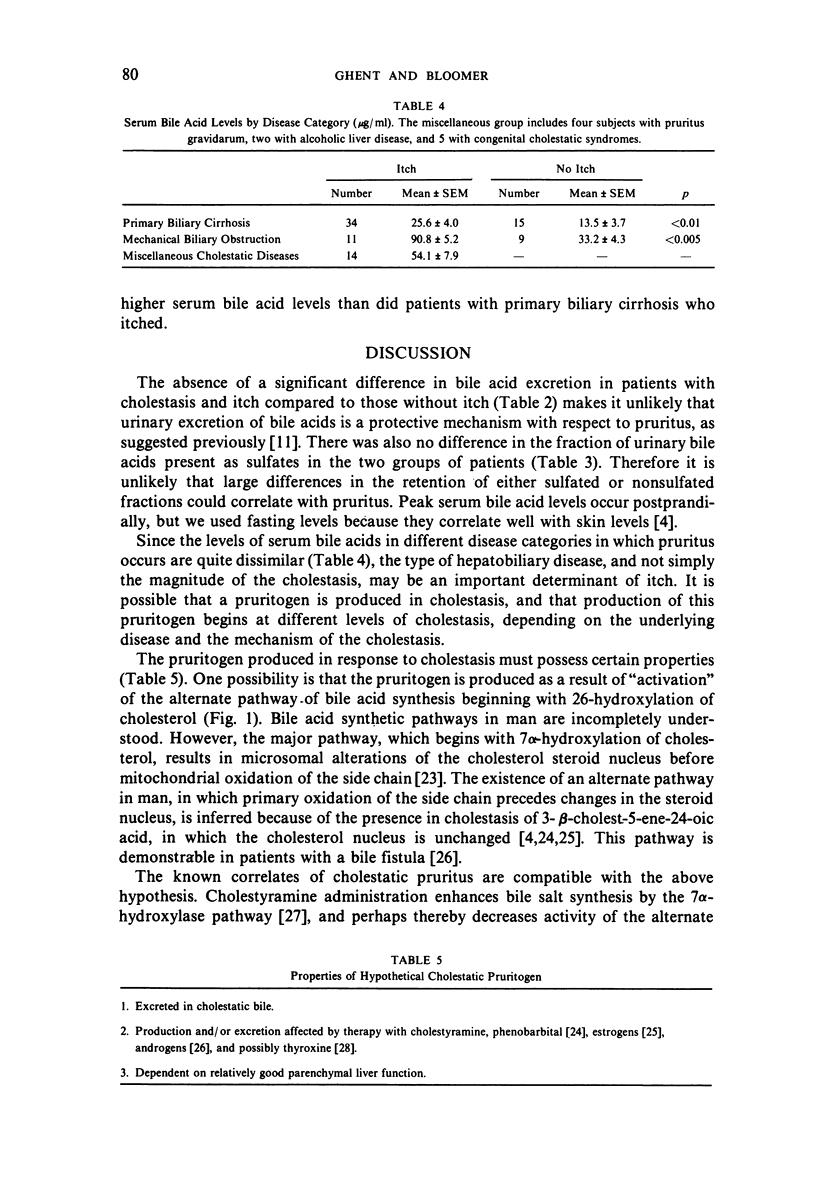
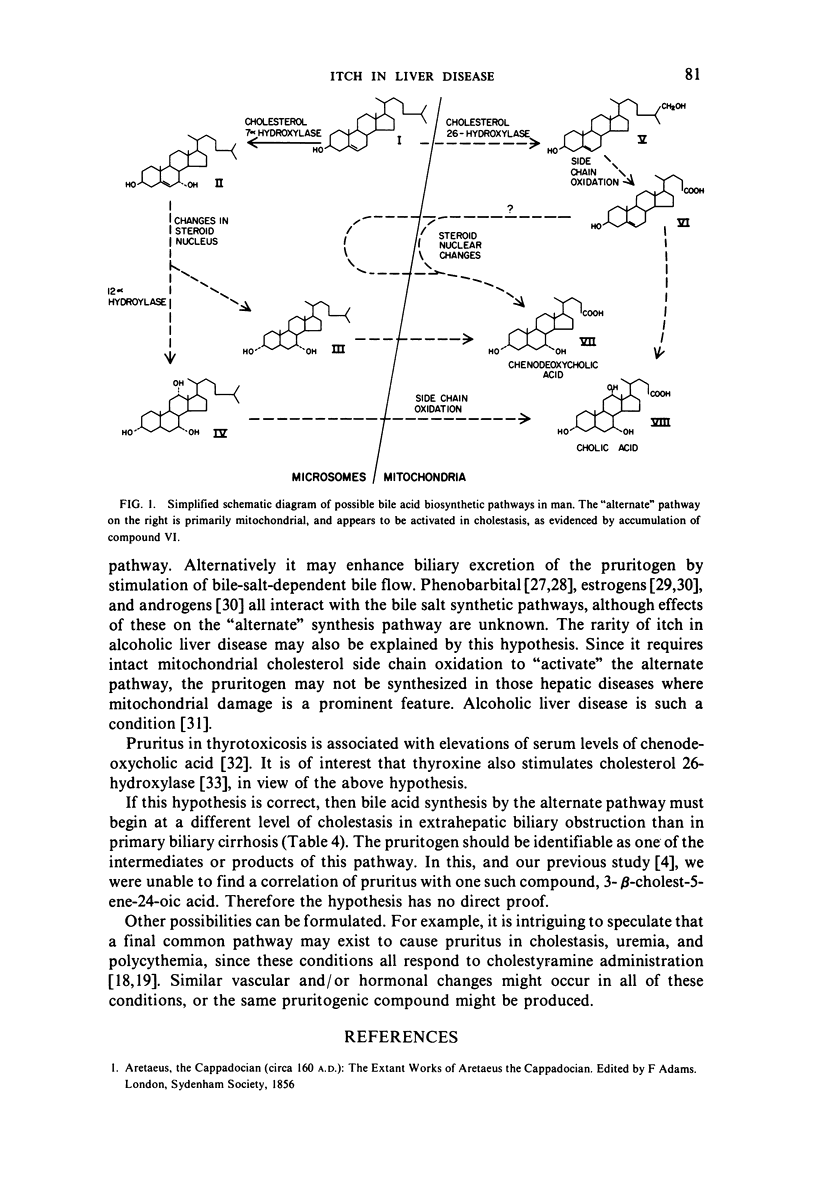
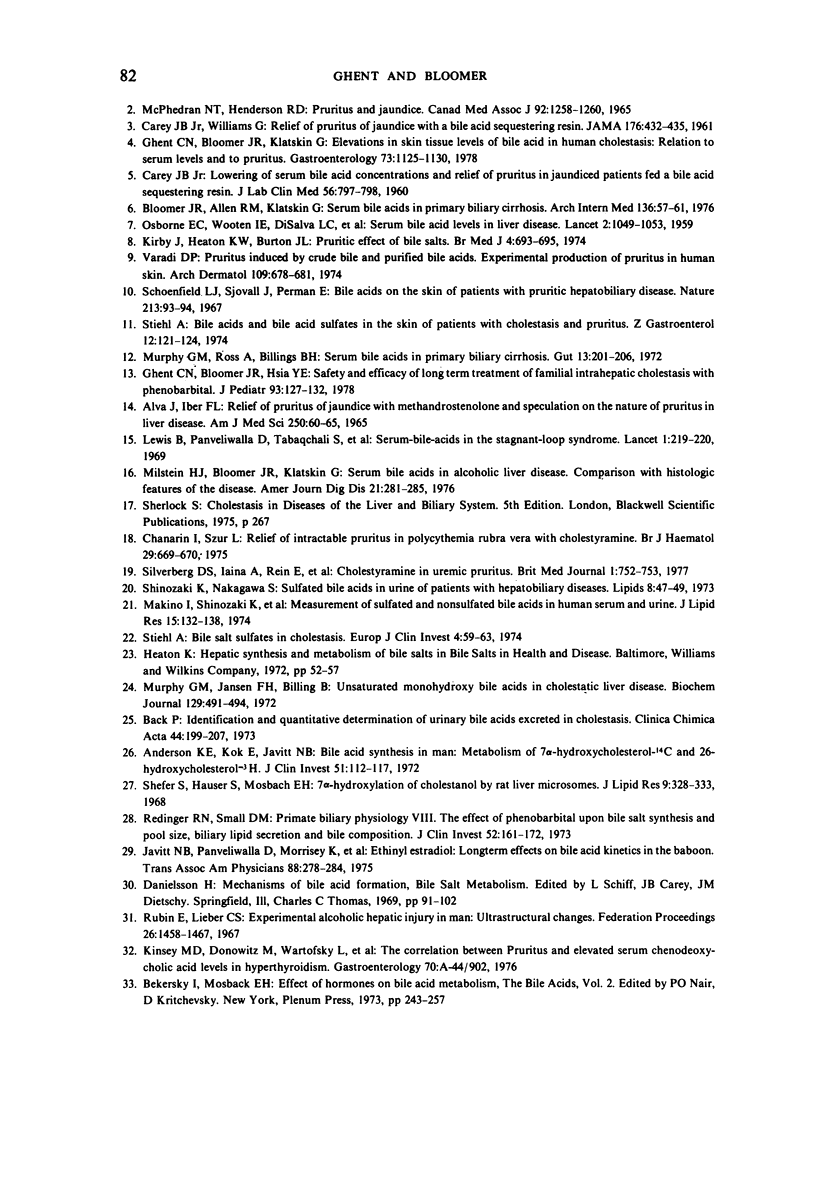
Selected References
These references are in PubMed. This may not be the complete list of references from this article.
- ALVA J., IBER F. L. RELIEF OF THE PRURITUS OF JAUNDICE WITH METHANDROSTENOLONE AND SPECULATIONS ON THE NATURE OF PRURITUS IN LIVER DISEASE. Am J Med Sci. 1965 Jul;250:60–65. doi: 10.1097/00000441-196507000-00009. [DOI] [PubMed] [Google Scholar]
- Anderson K. E., Kok E., Javitt N. B. Bile acid synthesis in man: metabolism of 7 -hydroxycholesterol- 14 C and 26-hydroxycholesterol- 3 H. J Clin Invest. 1972 Jan;51(1):112–117. doi: 10.1172/JCI106780. [DOI] [PMC free article] [PubMed] [Google Scholar]
- Back P. Identification and quantitative determination of urinary bile acids excreted in cholestasis. Clin Chim Acta. 1973 Mar 14;44(2):199–207. doi: 10.1016/0009-8981(73)90382-3. [DOI] [PubMed] [Google Scholar]
- Bloomer J. R., Allen R. M., Klatskin G. Serum bile acids in primary biliary cirrhosis. Arch Intern Med. 1976 Jan;136(1):57–61. [PubMed] [Google Scholar]
- CAREY J. B., Jr, WILLIAMS G. Relief of the pruritus of jaundice with a bile-acid sequestering resin. JAMA. 1961 May 6;176:432–435. doi: 10.1001/jama.1961.03040180034008. [DOI] [PubMed] [Google Scholar]
- Chanarin I., Szur L. Letter: Relief of intractable pruritus in polycythaemia rubra vera with cholestyramine. Br J Haematol. 1975 Apr;29(4):669–670. doi: 10.1111/j.1365-2141.1975.tb02753.x. [DOI] [PubMed] [Google Scholar]
- Ghent C. N., Bloomer J. R., Hsia Y. E. Efficacy and safety of long-term phenobarbital therapy of familial cholestasis. J Pediatr. 1978 Jul;93(1):127–132. doi: 10.1016/s0022-3476(78)80625-8. [DOI] [PubMed] [Google Scholar]
- Ghent C. N., Bloomer J. R., Klatskin G. Elevations in skin tissue levels of bile acids in human cholestasis: relation to serum levels and topruritus. Gastroenterology. 1977 Nov;73(5):1125–1130. [PubMed] [Google Scholar]
- Javitt N. B., Panveliwalla D., Morrissey K., Kok E., Peterson R. Ethinyl estradiol: long term effects on bile acid kinetics in the baboon. Trans Assoc Am Physicians. 1975;88:278–284. [PubMed] [Google Scholar]
- Kirby J., Heaton K. W., Burton J. L. Pruritic effect of bile salts. Br Med J. 1974 Dec 21;4(5946):693–695. doi: 10.1136/bmj.4.5946.693. [DOI] [PMC free article] [PubMed] [Google Scholar]
- Lewis B., Tabaqchali S., Panveliwalla D., Wootton I. D. Serum-bile-acids in the stagnant-loop syndrome. Lancet. 1969 Feb 1;1(7588):219–220. doi: 10.1016/s0140-6736(69)91238-0. [DOI] [PubMed] [Google Scholar]
- MCPHEDRAN N. T., HENDERSON R. D. PRURITUS AND JAUNDICE. Can Med Assoc J. 1965 Jun 12;92:1258–1260. [PMC free article] [PubMed] [Google Scholar]
- Makino I., Shinozaki K., Nakagawa S., Mashimo K. Measurement of sulfated and nonsulfated bile acids in human serum and urine. J Lipid Res. 1974 Mar;15(2):132–138. [PubMed] [Google Scholar]
- Milstein H. J., Bloomer J. R., Klatskin G. Serum bile acids in alcoholic liver disease. Comparison with histological features of the disease. Am J Dig Dis. 1976 Apr;21(4):281–285. doi: 10.1007/BF01071839. [DOI] [PubMed] [Google Scholar]
- Murphy G. M., Jansen F. H., Billing B. H. Unsaturated monohydroxy bile acids in cholestatic liver disease. Biochem J. 1972 Sep;129(2):491–494. doi: 10.1042/bj1290491. [DOI] [PMC free article] [PubMed] [Google Scholar]
- Murphy G. M., Ross A., Billing B. H. Serum bile acids in primary biliary cirrhosis. Gut. 1972 Mar;13(3):201–206. doi: 10.1136/gut.13.3.201. [DOI] [PMC free article] [PubMed] [Google Scholar]
- OSBORN E. C., WOOTTON I. D., da SILVA L., SHERLOCK S. Serum-bile-acid levels in liver disease. Lancet. 1959 Dec 12;2(7111):1049–1053. doi: 10.1016/s0140-6736(59)91527-2. [DOI] [PubMed] [Google Scholar]
- Redinger R. N., Small D. M. Primate biliary physiology. 8. The effect of phenobarbital upon bile salt synthesis and pool size, biliary lipid secretion, and bile composition. J Clin Invest. 1973 Jan;52(1):161–172. doi: 10.1172/JCI107160. [DOI] [PMC free article] [PubMed] [Google Scholar]
- Rubin E., Lieber C. S. Experimental alcoholic hepatic injury in man: ultrastructural changes. Fed Proc. 1967 Sep;26(5):1458–1467. [PubMed] [Google Scholar]
- Shefer S., Hauser S., Mosbach E. H. 7-alpha-hydroxylation of cholestanol by rat liver microsomes. J Lipid Res. 1968 May;9(3):328–333. [PubMed] [Google Scholar]
- Shinozaki K., Nakagawa S. Sulfated bile acid in urine of patients with hepatobiliary diseases. Lipids. 1973 Jan;8(1):47–49. doi: 10.1007/BF02533240. [DOI] [PubMed] [Google Scholar]
- Silverberg D. S., Iaina A., Reisin E., Rotzak R., Eliahou H. E. Cholestyramine in uraemic pruritus. Br Med J. 1977 Mar 19;1(6063):752–753. doi: 10.1136/bmj.1.6063.752. [DOI] [PMC free article] [PubMed] [Google Scholar]
- Stiehl A. Bile salt sulphates in cholestasis. Eur J Clin Invest. 1974 Feb;4(1):59–63. doi: 10.1111/j.1365-2362.1974.tb00373.x. [DOI] [PubMed] [Google Scholar]
- Stiehl A. Gallensäuren und Gallensäurensulfate in der Haut von Patienten mit Cholestase und Juckreiz. Z Gastroenterol. 1974 Mar;12(2):121–124. [PubMed] [Google Scholar]
- Varadi D. P. Pruritus induced by crude bile and purified bile acids. Experimental production of pruritus in human skin. Arch Dermatol. 1974 May;109(5):678–681. [PubMed] [Google Scholar]


